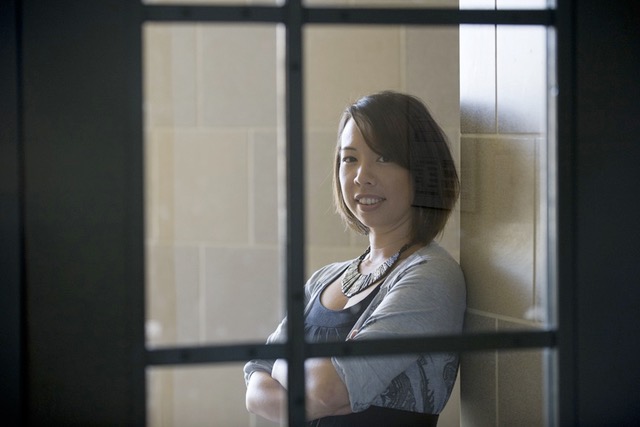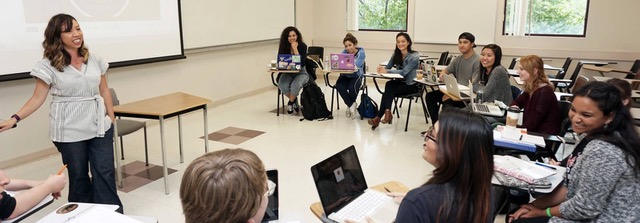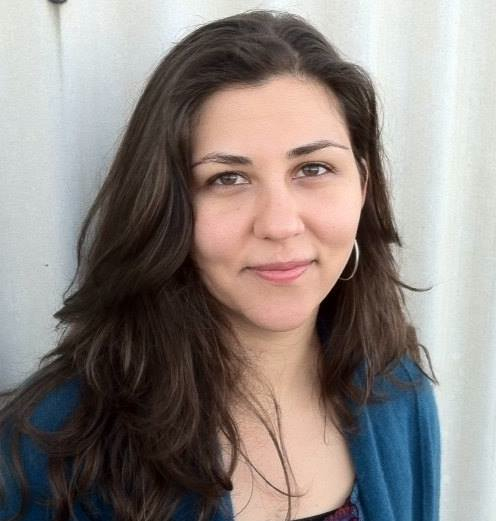
Erika Hayasaki teaches in the Literary Journalism Program at UC Irvine after working for the L.A. Times.
EDITOR’S NOTE: Erika Hayasaki’s conversation with Storyboard contributor Katia Savchuk explores what it took to earn a regular byline in magazines. She also shared the two separate pitches she wrote to land “End Pain Forever” as a cover piece in Wired. Check back next week (Aug. 28) in Annotation Tuesday! to find out why her first pitch was rejected and how she revised it.
Erika Hayasaki spent nine years as a reporter at the Los Angeles Times before leaving in 2009 to teach, write a book (The Death Class: A True Story About Life) and freelance for magazines. She soon realized that her experience as an award-winning feature writer at the newspaper didn’t translate seamlessly into the magazine world. “I didn’t know how to write a pitch or who to pitch, and I would never get a reply,” she says. “I had to start from scratch.”So Hayasaki worked her way up, first writing for digital publications, including Narratively, the Big Roundtable and now-defunct Matter. In 2014, she published “Drowned by Corn,” as a Kindle Single, about a group of boys who died in a grain bin in Illinois. Getting longform pieces published online eventually raised Hayasaki’s profile among editors at established magazines.
“You have to hit a couple of home runs, show the world that you can do this, and eventually editors will find you,” she says. “It might take a couple of years, but people will start to reach out, and doors will open.”
Hayasaki now writes for publications such as Wired, The Atlantic, Glamour and others, mostly about science. She’s working on her second nonfiction book, which tells the story of Vietnamese twins separated at birth and later reunited; one was raised by a rich family in the Midwest, the other in a Vietnamese village. Hayasaki also teaches literary journalism at UC Irvine; she and her husband have a 4-year-old daughter and 1-year-old twin sons.
We chatted about finding story ideas, navigating the emotional ups and downs of freelancing, and juggling it all with marriage and motherhood. Our conversation below has been edited for length and clarity.
Where do you find story ideas?
I often start with a question or world that interests me. For example, my Kindle Single started when I was looking up news about avalanches and found a headline about boys who drowned in corn. It sounded insane and was a way to explore our dependence on corn.
What I’ve come to tell myself is: I’m not just one story, or even one book. It’s not going to be an overnight success story. It’s a long journey, and I’m committed to putting in the work, but I don’t define myself by that work.
Once you have a world that fascinates you, you have to get access to people who can carry a feature story. With the corn story, I showed up in the community and found survivors. In a science story, you might begin with a study and find the people involved in the research or affected by it. The characters have to be willing to open up and spend time with you and must have a compelling story that is a microcosm of a bigger issue. (Hayasaki shares more thoughts on finding ideas in a 2015 blog post.)
I’ll give you an example of starting with a question. I stumbled across a study about frontotemporal dementia, which is a condition that affects moral decision-making and behavior. I learned that a lot of these individuals end up breaking the law more than people with other neurological conditions. I put that term into Nexis to look for court cases where the condition had come up, and stumbled across a guy in California who’d gone to federal prison. I looked up the court transcripts in PACER, then used Intelius to track down his family. I found the guy in prison through an app called JPay, and the next thing I know I was able to visit the prison. I wrote the piece, “A Criminal Mind,” for The California Sunday Magazine.
We all know that “nothing is original,” but how do you decide if an idea that’s already been written about is still ripe?
Some of the best longform articles or books started out as something else – the person who wrote the one you remember just did it longer and better. Truman Capote saw a brief newspaper article and turned it into In Cold Blood. Longform writers are at an advantage today because so much work regurgitates the same thing. There are opportunities all over the place to go deeper, whether it’s a science journal headline or a newspaper article. You can go back a week later, or a year later, to a story you think can be bigger and better. Sometimes things have changed dramatically, and you’re the only one who will have the whole story.
Longform writers are at an advantage today because so much work regurgitates the same thing.
How do you know when you have a book idea on your hands, rather than a magazine article? Have your books grown out of articles?
A book has to be something you’re willing to commit yourself to for three or four years, or beyond. Do you
love it enough to keep talking and thinking about it? Is there more to the story than you could get into a magazine article, even if you had 20,000 words? Does it open up a world and have fascinating characters whose lives and experiences tell us about that world? With an article, you need one to three central characters; with a book, ask yourself if there are potentially five characters you can go deep with. You’re also going to be around for a really long time—are they open to giving you that kind of access? I’ve had ideas that I thought would’ve been good books, but they haven’t sold. The book industry is very market-driven, always trying to find the next bestseller.
My first book was based on a newspaper article that got a lot of attention. I had already developed a relationship with an agent and told her about it in conversation. She encouraged me to write a proposal, which is basically like a magazine article plus marketing document. A good agent will work with you on a proposal like an editor works with you on a story. My second book (on the reunited Vietnamese twins) came out of my own interest and research – it hasn’t been written about anywhere yet.
Communicating with editors can be challenging for freelancers, who are met with plenty of silence, rejection and ghosting. What’s your approach?
I’ve definitely been ghosted. Sometimes editors have pursued me, gotten pitches out of me, responded and then fell off the map. They probably took it to someone above them who didn’t approve. Because I’ve done stints as an editor, I understand they’re doing so much these days: getting dozens of pitches a week, editing
Once you have a world that fascinates you, you have to get access to people who can carry a feature story.
stories and often writing, too. I try to keep in mind how busy they are and give them a couple of weeks or longer, but I don’t feel guilty about following up. If there’s no response after the first follow-up, I usually go elsewhere. When I find editors I really like who are open to my ideas, I keep those relationships going, even if the publications aren’t as high-profile or well-paying.Do you think it’s possible financially to be a full-time freelancer for magazines?
I honestly don’t know how people do it these days. I teach and currently have support from (the Alicia Patterson Foundation) fellowship. When I ask people how they do it, many explain that they’ve had to diversify their careers. They might have one writing gig with steady pay, even if it’s not a dream job, and then pursue a couple of ambitious longform pieces a year. If they’re younger, maybe they work for Uber or Starbucks. Content marketing has also opened a lot of doors for writers. With straight magazine writing, it sometimes takes a year to get a piece in because it sits around, and you might get paid three months later. You can’t depend on that—you have to find a regular source of income so you can pursue your passion projects.

Freelancer Erika Hayasaki now teaches at UC Irvine.
You’ve written about the relationship between motherhood and creativity. Tell me a bit about how you juggle your writing with parenting three small children and teaching.
I’m probably overambitious with reporting and writing since it’s very fulfilling to me. Right now, I have two other magazine pieces in the works that I’ll submit in the next six months, one piece in the approval process, and a bunch of ideas in the early stages. So I’m working on about five in-depth stories at a time, plus I have other ideas forming but not yet pitched. And I’m working on my book project. I’m a little crazy, but luckily teaching affords me stretches of time in which I’m supposed to be doing my own writing.
When I had the twins, I thought, “I don’t know how I’ll write again.” But a year later, my mind started jumping on all these new ideas. I don’t think being a parent kills your magazine career. You become more
…you have to find a regular source of income so you can pursue your passion projects.
efficient with your time. Before I had kids, I could write into the night uninterrupted. Now, I have to stop at a certain time and pick back up when I can. I have to be very strict with myself to use those windows fully. Sometimes the writing just doesn’t come to you in that period, and that’s frustrating.It’s harder to take off traveling, but that doesn’t mean you can never do it. When I had just one kid, she would often travel with me, and I arranged childcare while doing interviews. This year, I’ll do some overseas reporting for my book. My daughter is 4, and the other night we had a discussion about what passion is. I wanted her to understand why I’d be gone for a week. I’m passionate about my kids and passionate about my work, and that makes me a better mother. I also have a great husband and family.
Freelancing for magazines can involve so many factors outside of your control, from sources backing out, to getting scooped, to editorial changes at a publication. What’s your advice for dealing with the emotional rollercoaster?
When I started at the Los Angeles Times, I was surrounded by superstars and always had Imposter Syndrome. My response was to work really hard and try to get to their level. When I left newspapers, I had to start all over, and it was a great lesson. I was getting rejections, people weren’t responding, I was getting screwed in so many ways. There were mean comments and shitty book reviews.
You develop a thicker skin as the years go on. What I’ve come to tell myself is: I’m not just one story, or even one book. It’s not going to be an overnight success story. It’s a long journey, and I’m committed to putting in
When I left newspapers, I had to start all over, and it was a great lesson.
the work, but I don’t define myself by that work. I’m trying to do the best I can with my writing career with the time and energy I have. I remember that I’m not just a writer, but also a mother, a teacher, etc. If you get a rejection, you can hang out with your friends or go to a concert or play with your kids or spend time with your husband. You can separate yourself from it and recognize that it’s all part of the up-and-down struggle facing everyone who is in a creative field.I’m also part of a group of longform writers in L.A. who meet every month to check in about rejections, go over drafts and pitches, share contacts and encourage each other. It helps us realize that we’re all going through the same thing. It’s easy to quit, since nobody is out there waiting for your next longform story. You have to drive yourself.
Coming next week: See Annotation Tuesday! for an analysis of two pitches – the original rejected, the rewrite accepted – that landed “End Pain Forever” as a cover story in Wired.


